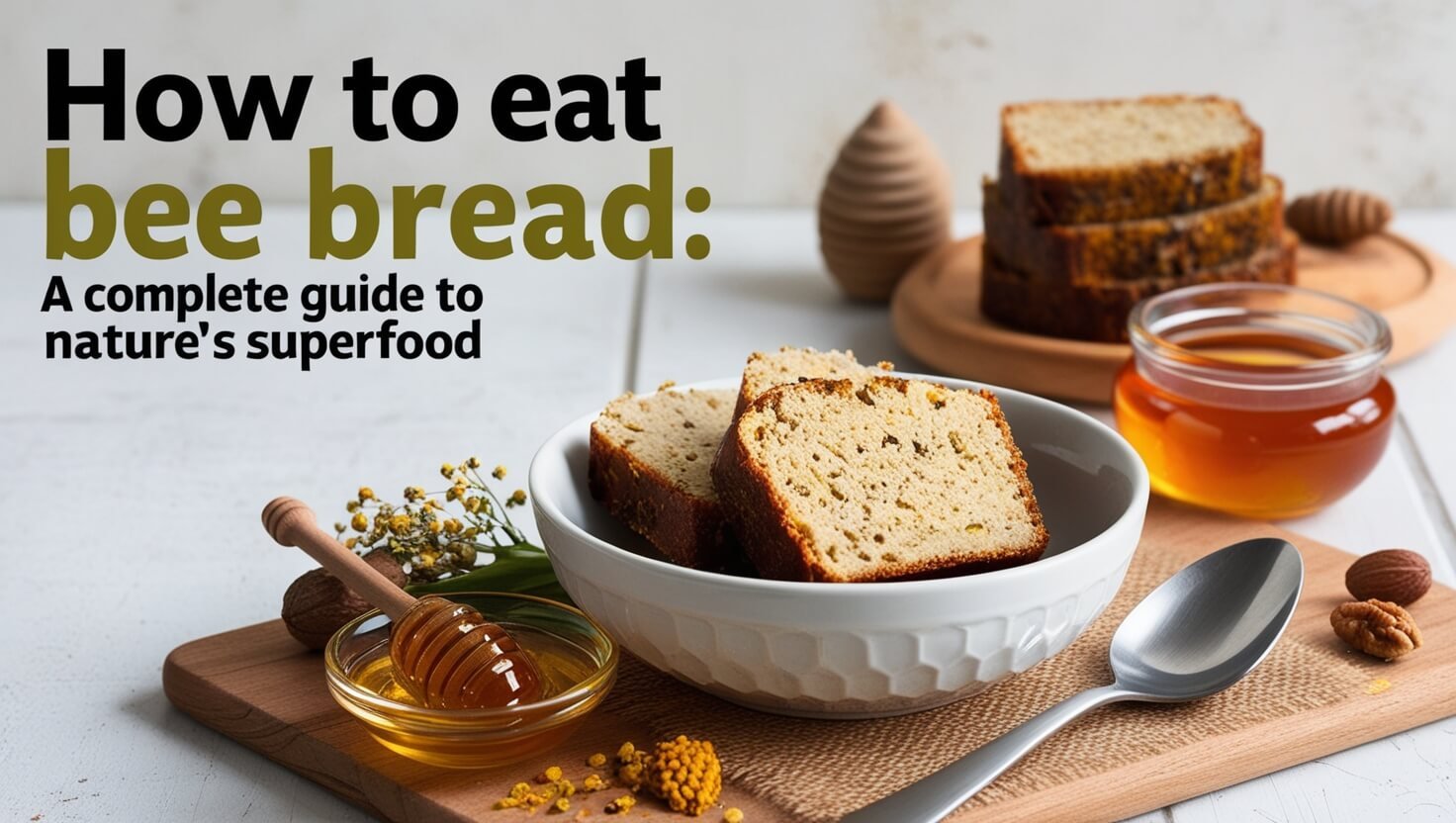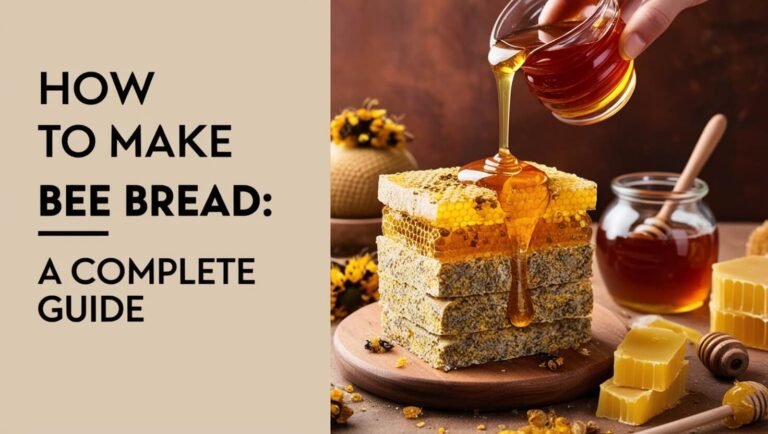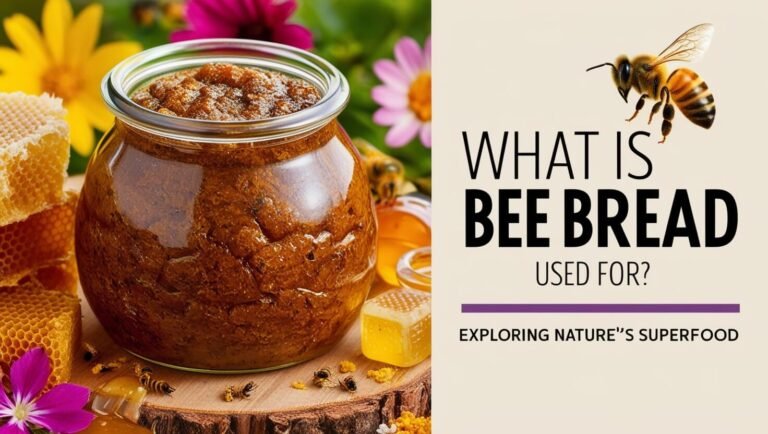How to Eat Bee Bread: A Complete Guide to Nature’s Superfood

Bee bread is a remarkable superfood created by nature’s tiny workers – honeybees. If you’re curious about how to eat bee bread and harness its incredible health benefits, you’ve come to the right place. This comprehensive guide will walk you through everything you need to know about consuming this nutritional powerhouse, from its origins to the best ways to incorporate it into your diet.
What is Bee Bread?
Before we dive into how to eat bee bread, let’s understand what it is. Bee bread is a fermented mixture of pollen, honey, and bee saliva that bees create as a food source for their colony. It’s not the same as raw bee pollen – it’s better!
How Bees Make Bee Bread
Forager bees collect pollen from various flowers and mix it with nectar and enzymes from their saliva. They then pack this mixture into honeycomb cells, where it undergoes lactic acid fermentation. This process transforms the pollen into a more digestible and nutrient-dense substance – bee bread.
Nutritional Profile
Bee bread is a nutritional powerhouse. It contains:
- Proteins (up to 35%)
- Carbohydrates (up to 53%)
- Lipids (up to 6%)
- Vitamins (B1, B2, B6, C, E, K)
- Minerals (calcium, magnesium, iron, zinc)
- Enzymes
- Antioxidants
This unique composition makes bee bread a highly sought-after supplement for those looking to boost their overall health and wellness.
Health Benefits of Eating Bee Bread
Incorporating bee bread into your diet can offer numerous health benefits. Here’s why you might want to start eating bee bread:
Immune System Support
The rich array of vitamins, minerals, and antioxidants in bee bread can help strengthen your immune system. Regular consumption may help your body fight off infections and diseases more effectively.
Digestive Health
Thanks to its fermented nature, bee bread contains beneficial probiotics that support gut health. These good bacteria can improve digestion and help maintain a balanced gut microbiome.
Energy and Vitality
The high protein content and complex carbohydrates in bee bread provide sustained energy throughout the day. Many people report feeling more energetic and vital when they start eating bee bread regularly.
Antioxidant Properties
Bee bread is packed with antioxidants that help combat oxidative stress in the body. This can lead to better overall health and may even slow down the aging process.
Potential Allergy Relief
Some studies suggest that consuming local bee bread may help alleviate seasonal allergies. The theory is that small amounts of local pollen in the bee bread can help desensitize your body to allergens over time.
Sourcing High-Quality Bee Bread
To reap the full benefits of bee bread, it’s crucial to source high-quality products. Here’s how:
Local Beekeepers and Farmers Markets
The best place to find fresh, high-quality bee bread is often your local beekeeper or farmers market. This ensures you’re getting a product that’s fresh and likely made from local pollen sources.
Reputable Online Suppliers
If you can’t find bee bread locally, look for reputable online suppliers. Make sure they have good reviews and provide information about their sourcing and production methods.
What to Look for When Purchasing
When buying bee bread, consider these factors:
- Color: Should be varied, reflecting different pollen sources
- Texture: Slightly moist but not wet or moldy
- Smell: Pleasant, slightly sweet aroma
- Packaging: Properly sealed to maintain freshness
- Source: Preferably from a local or well-known beekeeper
Preparing Bee Bread for Consumption
Once you’ve sourced your bee bread, it’s important to handle and prepare it correctly:
Proper Storage Techniques
Store bee bread in an airtight container in a cool, dry place. You can keep it in the refrigerator to extend its shelf life, but avoid exposing it to moisture.
Cleaning and Inspection
Before eating, inspect your bee bread for any signs of mold or unusual discoloration. If you notice anything off, it’s best to discard it.
Portioning for Daily Use
Portion out your bee bread for daily use to avoid contaminating the entire batch. A typical serving is about 1-2 teaspoons per day.
Different Ways to Eat Bee Bread
Now, let’s explore the various ways you can enjoy bee bread:
Raw Consumption
The simplest way to eat bee bread is raw. Take a small amount (about 1 teaspoon) and let it dissolve slowly in your mouth. This allows for better absorption of nutrients.
Mixed with Honey
For a sweeter treat, mix bee bread with raw honey. This combination not only tastes great but also provides additional health benefits from the honey.
Added to Smoothies and Shakes
Bee bread makes an excellent addition to smoothies and protein shakes. Its nutty flavor complements fruit and vegetable smoothies well.
Sprinkled on Yogurt or Cereal
Sprinkle bee bread on top of your morning yogurt or cereal for an extra nutritional boost. It adds a pleasant texture and subtle flavor.
Incorporated into Baked Goods
You can add bee bread to baked goods like muffins, bread, or energy bars. Be careful not to expose it to high temperatures for too long, as this can degrade some of its nutritional value.
Used as a Natural Sweetener
Bee bread can be used as a natural sweetener in teas or other beverages. It adds a unique flavor along with its nutritional benefits.
Recommended Dosage and Timing
When it comes to eating bee bread, moderation is key. Here’s how to approach dosage:
Starting with Small Amounts
If you’re new to bee bread, start with a small amount – about 1/4 to 1/2 teaspoon per day. This allows your body to adjust and helps you identify any potential sensitivities.
Gradually Increasing Intake
Over time, you can gradually increase your intake to 1-2 teaspoons per day. Listen to your body and adjust as needed.
Best Times of Day to Consume Bee Bread
Many people prefer to eat bee bread in the morning on an empty stomach for optimal absorption. However, you can consume it at any time of day that works best for you.
Potential Side Effects and Precautions
While bee bread is generally safe for most people, there are some precautions to keep in mind:
Allergic Reactions
If you’re allergic to pollen or bee products, you may also be allergic to bee bread. Start with a very small amount and watch for any adverse reactions.
Interactions with Medications
Bee bread may interact with certain medications, particularly blood thinners. Consult with your healthcare provider before adding bee bread to your diet if you’re on any medications.
Pregnancy and Breastfeeding Considerations
While bee bread is nutrient-rich, pregnant or breastfeeding women should consult with their healthcare provider before consuming it.
Bee Bread vs. Other Bee Products
It’s worth understanding how bee bread compares to other bee products:
Comparison with Bee Pollen
Bee bread is more nutritious and easier to digest than raw bee pollen due to the fermentation process.
Differences from Royal Jelly and Propolis
While all bee products have health benefits, bee bread is particularly high in protein and fermented nutrients, setting it apart from royal jelly and propolis.
Complementary Use with Honey
Bee bread and honey complement each other well. Many people enjoy consuming them together for enhanced flavor and health benefits.
Incorporating Bee Bread into Your Diet
Here are some ideas for making bee bread a regular part of your diet:
Meal Planning Ideas
- Breakfast: Add to oatmeal or yogurt
- Lunch: Sprinkle on salads
- Snack: Mix with nuts and dried fruits for a homemade trail mix
- Dinner: Incorporate into salad dressings or sauces
Recipes Featuring Bee Bread
- Bee Bread Energy Balls
- Mix 1/4 cup bee bread with 1 cup almond butter, 1/2 cup honey, 1 cup oats, and 1/4 cup chia seeds. Roll into balls and refrigerate.
- Bee Bread Smoothie
- Blend 1 banana, 1 cup almond milk, 1 tbsp bee bread, 1 tbsp honey, and a handful of spinach.
- Bee Bread Salad Dressing
- Whisk together 2 tbsp olive oil, 1 tbsp lemon juice, 1 tsp bee bread, and a pinch of salt and pepper.
Combining with Other Superfoods
Bee bread pairs well with other superfoods like chia seeds, goji berries, and spirulina. Experiment with combinations to find what works best for you.
Storing and Preserving Bee Bread
Proper storage is crucial to maintain the quality of your bee bread:
Proper Containers
Store bee bread in airtight glass or food-grade plastic containers to protect it from moisture and contaminants.
Temperature and Humidity Control
Keep bee bread in a cool, dry place. The ideal temperature is between 50-70°F (10-21°C) with low humidity.
Freezing for Long-term Storage
For long-term storage, you can freeze bee bread. Divide it into small portions and store in airtight containers or freezer bags. It can last up to a year when frozen.
Sustainability and Ethical Considerations
As you enjoy the benefits of bee bread, consider the broader impact:
Supporting Local Beekeepers
Buying bee bread from local beekeepers supports sustainable beekeeping practices and helps maintain bee populations.
Environmental Impact of Bee Bread Production
Bee bread production is generally sustainable as it’s a natural byproduct of bee activity. However, it’s important to ensure it’s harvested in a way that doesn’t harm the bee colonies.
Responsible Harvesting Practices
Look for bee bread that’s harvested using responsible practices that prioritize the health and wellbeing of the bee colonies.
Frequently Asked Questions about Eating Bee Bread
Can Children Eat Bee Bread?
Yes, children can generally eat bee bread, but start with very small amounts and consult with a pediatrician, especially for children under 12 months old.
How Long Does Bee Bread Last?
Properly stored, bee bread can last up to 6 months in the refrigerator and up to a year in the freezer.
Can Bee Bread Help with Seasonal Allergies?
Some people report relief from seasonal allergies when consuming local bee bread, but scientific evidence is limited. It’s best to consult with an allergist.
Is Bee Bread Suitable for Vegans?
This is a debated topic. Some vegans consider bee products off-limits, while others may consume them if they come from ethical, sustainable sources. It’s a personal choice.
In Closing
Eating bee bread can be a delicious and nutritious addition to your diet. From its rich nutritional profile to its versatility in recipes, bee bread offers numerous ways to boost your health and wellness. Remember to start small, listen to your body, and enjoy the journey of incorporating this natural superfood into your lifestyle.
Whether you choose to eat bee bread raw, mix it with honey, or add it to your favorite recipes, you’re tapping into a nutrient-dense food that honeybees have perfected over millions of years. So why not give it a try? Your body might just thank you for it.




